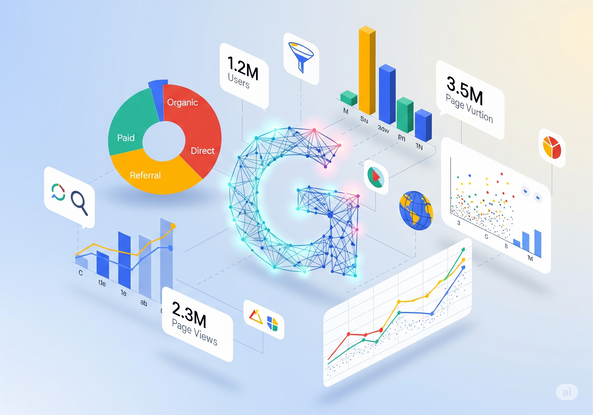
What is Google Analytics and How Does It Work?
Introduction
In today’s data-driven digital marketing landscape, understanding user behavior is essential. Whether you’re running a blog, eCommerce website, or corporate portal, knowing how visitors interact with your site helps you make smarter business decisions. That’s where Google Analytics comes in.
Google Analytics is a powerful web analytics tool developed by Google that tracks and reports website traffic. It's widely used by businesses, marketers, and developers to gather insights and optimize performance.
What is Google Analytics?Google Analytics is a free digital analytics platform that allows website owners to measure the performance of their online presence. It helps track metrics such as:
-
Number of users and sessions
-
Page views and bounce rate
-
Traffic sources (organic, direct, paid, social)
-
Device and geographic data
-
Conversions and goal completions
In 2025, Google Analytics 4 (GA4) has become the standard, replacing Universal Analytics with a more advanced, event-based tracking system.
Why is Google Analytics Important in 2025?-
Event-Based Tracking with GA4
Unlike its predecessor, GA4 focuses on user events (like scrolls, clicks, and video plays) rather than sessions. This gives more granular insights into how users actually engage with your content. -
Cross-Platform Tracking
You can track both websites and mobile apps in a single property, making it ideal for businesses offering hybrid digital experiences. -
AI-Powered Insights
GA4 uses machine learning to predict user behavior and offer automated insights, such as churn probability or purchase likelihood—key for making proactive decisions. -
Privacy-Centric
GA4 is designed for a cookieless future, aligning with evolving privacy laws (like GDPR and CCPA) and giving users more control over their data.
Google Analytics works by placing a tracking code (a small JavaScript snippet) on every page of your website. This code collects data and sends it to Google’s servers, where it’s processed and displayed in your GA dashboard.
Here’s how the process works:-
User Visits Your Website
A user lands on your website or app, and the tracking code collects data about their session. -
Data Is Captured in Real-Time
Information such as device type, location, traffic source, and actions performed (e.g., clicks, downloads) is recorded. -
Data Is Processed and Organized
Google Analytics organizes this data into reports and visualizations for easier interpretation. -
You Analyze and Act
Use this data to measure performance, identify trends, understand what’s working, and make informed decisions.
-
Real-Time Reporting – See what’s happening on your site in real-time.
-
Audience Insights – Understand your users’ demographics, interests, and location.
-
Acquisition Reports – Know how users are finding your website.
-
Behavior Flow – Visualize the paths users take through your site.
-
Goal Tracking – Measure conversions, form fills, sales, or other actions.
-
Integration with Google Ads – Easily track the performance of your paid campaigns.
-
Create a Google Analytics Account
Visit analytics.google.com and sign in with your Google account. -
Set Up a GA4 Property
GA4 is the default version now. Follow the setup guide to create a property. -
Install Tracking Code
Add the GA4 tracking ID (G-XXXXXXXXX) to your website header, or use tools like Google Tag Manager for more advanced implementation. -
Configure Events and Goals
Track key user interactions such as purchases, video views, or form submissions. -
Explore Reports and Dashboards
Use predefined reports or create custom dashboards to monitor KPIs relevant to your business.
-
Use custom event tracking for detailed insights.
-
Set up funnels to analyze user journeys.
-
Link GA4 to Google Search Console and Google Ads for integrated reporting.
-
Utilize exploration reports in GA4 to uncover hidden trends.
-
Schedule regular reporting for stakeholders using automated email reports.
Google Analytics remains one of the most vital tools in any digital marketer’s toolbox. With GA4’s upgraded capabilities, businesses in 2025 can make data-driven decisions faster, improve user experience, and drive better ROI.
Whether you're optimizing a blog, running a lead generation site, or scaling an eCommerce store, mastering Google Analytics helps you understand your audience, fine-tune campaigns, and reach your goals with precision.






